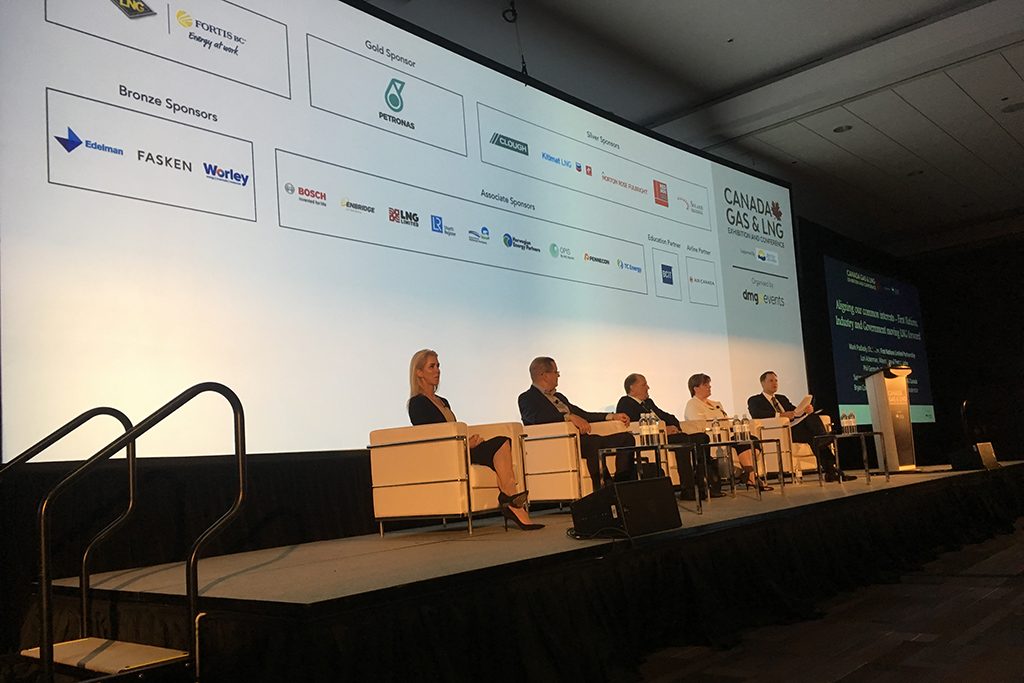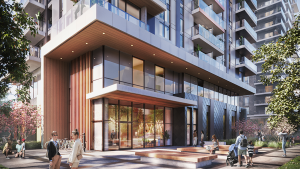A panel of representatives from First Nations, cities and LNG proponents gathered at this year’s Canada Gas & LNG Exhibition and Conference to explain how all three align their interests to move projects forward.
Lori Ackerman and Phil Germuth kicked off the discussion with their perspectives as mayor of Fort St. John and Kitimat, respectively.
Ackerman, currently overseeing the city as the Site C dam project is being built, urged proponents to consider the unique situation cities are in and other cities to embrace public comment.
“Local government is a creature of the province,” said Ackerman. “We are a delegated member of the government so quite often we don’t hear about projects until after they have been initiated with the two senior levels of government.”
She added that senior levels of government take in revenue but doesn’t have to stay and deal with the day-to-day issues on the ground a mega project brings.
“When you are talking to communities and how we align our common interests, the first thing that came to mind is that you really need to understand the operating environment that municipalities must deal with,” she said, explaining that cities are the only level of government required to have a tangible capital asset management program in place.
With Site C being built just seven km from the city’s downtown, Ackerman was adamant that the public have their say.
“We didn’t understand dam construction, so we had to go through an entire public process of public participation to understand what the impacts might be for the community and what the benefits might be,” she said.
When the project was being planned, some opposition already began forming in the city.
“The reality is that in our world, if everyone is happy, you aren’t doing your job,” said Ackerman, who did not let that allow the city to avoid discussion.
“If you are not afraid of what your community is going to say then you will be open to some good conversation, and by doing that you can find some good information, local knowledge, that will be brought to the table that will allow us to go forward to the joint review panel to get our community measures agreement that was precedent setting.”
Phil Germuth, mayor of Kitimat cited the city’s history of being founded for industry as part of its success.
“Kitimat exists only because of industry,” said Germuth.
The city was planned around an aluminum smelter and after that other industries, including paper and methane, followed. Now LNG Canada has made its final investment decision to build its $40 billion LNG facility near the city.
“LNG Canada was honestly a no-brainer,” said Germuth. “Not only is it a great product, but the way LNG Canada consulted and communicated was outstanding.”
Germuth explained that during the six years LNG Canada has been involved in the city, they have made extraordinary efforts to ensure anyone wanting to work has an opportunity.
The project has funded training programs, apprenticeships, scholarships and even childcare for single parents.
“In the Kitimat and Terrace area, if you are able to work, want to work, and want to enhance your quality of life by being a part of this project, there has been an opportunity for you,” said Germuth.
However, one of the biggest issues facing the city is restaurants, taxi services and other businesses reducing hours or closing due to lack of labour.
“We are really hoping the federal government can doing something with immigration because we really need temporary foreign workers to help us out right now,” said Germuth.
Mark Podlasly, director of the First Nations Limited Partnership, highlighted the evolution First Nations involvement in projects has seen. The partnership consists of 16 First Nations in a corporate structure with Kitimat LNG.
“It is unprecedented as far as we know, in terms of having First Nations having their interests put forward in a commercial project, in a commercial manner,” said Podlasly, explaining that the structure allows members to participate in procurement, training and opportunities that will come from a major LNG project.
“As much as this is groundbreaking, the pace of indigenous involvement in projects like this is accelerating, and the next stage of this is probably going to be towards equity positions in infrastructure projects,” said Podlasly. “Those discussions are happening in Canada and around the world.”
Finally, Susannah Pierce, director of LNG Canada’s corporate affairs, laid out why she believes LNG Canada is not only seizing a clear opportunity, but doing it the right way.
“The whole reason we are here is we see the opportunity of bringing that gas to places that need it, but in addition to that, what we have done here is different,” said Pierce. “What that ultimately means is that when we produce LNG here in Canada we have lower emissions then when you produce down on the U.S. Gulf Coast, or the Middle East, or Russia. And we have done that because we have been leading with, I believe, a value system here which puts a priority on those things.”
Pierce urged LNG critics to consider the global benefits of Canadian projects before opposing them.
“What I would say to those who would challenge us in developing in this province or country, is that you are cutting off your nose, to spite your face, and you are making the challenges of climate change more challenging,” she said. “We wouldn’t do this if we didn’t believe it was the right thing to do for community, country, province and our children.”
Pierce also advised other proponents to put in the work early on in building relationships, which pay off later on when tough discussions become inevitable.
“If we are able to have the strength of the relationship that we have developed in advance of FID carry us through those challenging discussions, when we build it and operate it, it will be something we can all be very proud of,” she said. “It takes a lot of effort to get to FID. It takes a lot of effort to get through construction and to operations. But I hope leveraging relationships we’ve developed over the years will allow us to have those difficult conversations and positive outcomes that we all seek for our communities.”











Recent Comments
comments for this post are closed